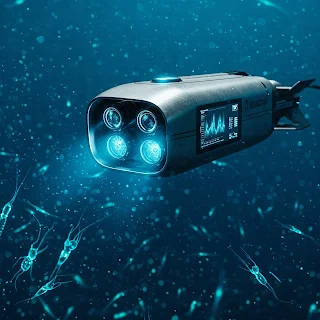Plankton are the foundation of aquatic food webs, playing a crucial role in ecosystem health, biodiversity, and global biogeochemical cycles. However, traditional methods of monitoring plankton populations rely heavily on manual sampling, which is often time-consuming, labor-intensive, and limited in coverage. To address these challenges, scientists have developed the Continuous Plankton Imaging and Classification System (CPICS)—an advanced instrument designed to automate the real-time monitoring of plankton biodiversity. By integrating high-resolution optics with real-time image processing, CPICS provides continuous, in situ analysis of plankton populations, offering a more efficient and comprehensive approach to aquatic ecosystem research.
The Importance of Plankton Monitoring
Plankton, both phytoplankton (microscopic plants) and zooplankton (tiny animals), serve as primary producers and key consumers in aquatic environments. Their abundance and diversity influence:
Marine food webs – Supporting fish populations and other marine life.
Carbon cycling – Regulating atmospheric CO2 by sequestering carbon in the ocean.
Water quality – Acting as indicators of pollution and ecosystem health.
Climate regulation – Contributing to the balance of oxygen and greenhouse gases.
With growing environmental concerns, monitoring plankton populations has become essential for understanding climate change impacts, ecosystem shifts, and biodiversity conservation.
Challenges in Traditional Plankton Monitoring
Historically, plankton monitoring involved manual sampling techniques, such as:
Net tows and bottle sampling – Collecting plankton samples for microscopic examination.
Microscopy analysis – Identifying and counting plankton species manually.
Satellite imaging – Observing large-scale phytoplankton blooms but lacking species-level detail.
These methods are often limited in spatial and temporal resolution, prone to human error, and require extensive laboratory analysis, leading to delays in data interpretation. The need for a more automated and precise system led to the development of CPICS.
What is CPICS?
The Continuous Plankton Imaging and Classification System (CPICS) is an advanced monitoring tool that combines high-resolution imaging with AI-driven classification algorithms. This cutting-edge technology provides real-time, automated plankton identification and quantification in natural aquatic environments.
Key Features of CPICS
High-Resolution Optics – Captures detailed images of plankton at microscopic scales.
Real-Time Image Processing – Uses machine learning to identify and classify plankton species instantly.
In Situ Monitoring – Operates continuously in aquatic environments without the need for sample collection.
Automated Data Collection – Reduces reliance on manual sampling and laboratory work.
Scalability – Can be deployed in multiple aquatic environments, from coastal waters to deep oceans.
How CPICS Works
1. Image Capture
CPICS utilizes advanced optical sensors to continuously scan water samples. The system is equipped with microscopic imaging technology, enabling it to capture high-resolution images of plankton in real-time.
2. AI-Powered Classification
Using deep learning algorithms, CPICS can automatically identify and classify different plankton species. The AI model is trained on vast datasets, allowing it to distinguish between species based on:
Shape and size
Color and texture
Movement patterns
3. Data Transmission and Analysis
CPICS transmits collected data wirelessly to research labs or cloud-based servers, enabling real-time analysis. Scientists can access:
Population density trends
Species diversity shifts
Environmental changes impacting plankton
Advantages of CPICS Over Traditional Methods
Applications of CPICS in Environmental Research
CPICS has the potential to transform various fields of marine and freshwater research:
1. Climate Change Studies
Plankton serve as climate indicators. CPICS can track changes in plankton populations in response to rising ocean temperatures, acidification, and pollution.
2. Fisheries and Marine Resource Management
By monitoring plankton abundance, CPICS helps predict fish population trends, aiding in sustainable fisheries management.
3. Water Quality Assessment
Since some plankton species indicate pollution levels, CPICS can be used for early detection of harmful algal blooms (HABs) and ecosystem degradation.
4. Biodiversity Conservation
Understanding shifts in plankton biodiversity assists in protecting endangered marine species and maintaining ecosystem balance.
Challenges and Future Improvements
Despite its many advantages, CPICS faces certain challenges:
High Initial Costs – Advanced imaging and AI integration require significant investment.
Data Storage Limitations – Continuous monitoring generates vast amounts of data, necessitating efficient storage solutions.
AI Model Training – Continuous updates are needed to improve species identification accuracy.
Future developments aim to:
Enhance AI accuracy through improved datasets.
Miniaturize CPICS systems for broader accessibility.
Integrate cloud-based analytics for global collaboration among researchers.
Conclusion
The development of CPICS marks a major leap forward in plankton monitoring and aquatic ecosystem research. By automating species identification and providing real-time data, CPICS overcomes the limitations of traditional methods, offering a more efficient and scalable solution. As environmental challenges continue to rise, innovative tools like CPICS will play a crucial role in safeguarding marine biodiversity, informing conservation efforts, and advancing our understanding of aquatic ecosystems.
With ongoing research and technological advancements, CPICS has the potential to revolutionize oceanography, climate science, and biodiversity monitoring, making it a game-changer in the field of environmental science.

No comments:
Post a Comment